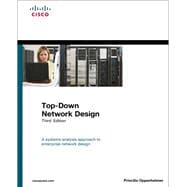Top-Down Network Design, Third Edition, is a practical and comprehensive guide to designing enterprise networks that are reliable, secure, and scalable. The book uses a top-down approach to help you focus first on applications and user requirements before selecting devices, cabling, and other technologies to implement the network. The book takes you through an explanation of how to design networks that align with business goals so that the network can keep pace with changing user requirements.
This new edition provides a comprehensive look at enterprise network design and the different modules of an enterprise network. Using illustrations and real-world examples, the book covers campus network design, wireless networks, remote access, and wide-area connectivity. You learn how to analyze business and technical requirements and select topologies and technologies that are based on that analysis. A major focus is on security as network users become more mobile. You also develop an understanding of network performance factors and methods for building reliable networks that can scale as traffic loads increase.
This Third Edition includes updated and expanded material on wireless networks, virtual private networks (VPN), network security, network redundancy, modularity in network designs, dynamic addressing for IPv4 and IPv6, Ethernet scalability options (including 10-Gbps Ethernet, Metro Ethernet, and Long-Reach Ethernet), and networks that carry voice and data traffic. In addition you will learn how to build networks that can support real-time video, collaborative computing, and social networking tools and that adhere to the Cisco SAFE Security Reference Architecture.
Every chapter now includes a set of essay questions and design scenarios to give you a chance to practice what you have learned. The book also has a companion website at www.topdownbook.com, which includes updates to the book, links to white papers, and supplemental information about design resources.
-Learn a network design process that results in networks that perform well, provide security, and scale to meet growing demands for bandwidth
-Develop network designs that provide the high bandwidth and low delay required for real-time applications such as multimedia, distance learning, videoconferencing, teleprescene, virtual communities, and IP telephony
-Master techniques for checking the health of an existing network to develop a baseline for measuring performance of a new network design
-Explore solutions for meeting QoS requirements, including IETF controlled-load and guaranteed services, IP multicast, and advanced switching, queuing, and routing algorithms
-Identify the advantages and disadvantages of various switching and routing protocols, including Rapid Spanning Tree Protocol (RSTP), IEEE 802.1Q, EIGRP, OSPF, and BGP4
This book is part of the Networking Technology Series from Cisco Press‚ which offers networking professionals valuable information for constructing efficient networks, understanding new technologies, and building successful careers.
Category: Networking
Covers: Network Design









